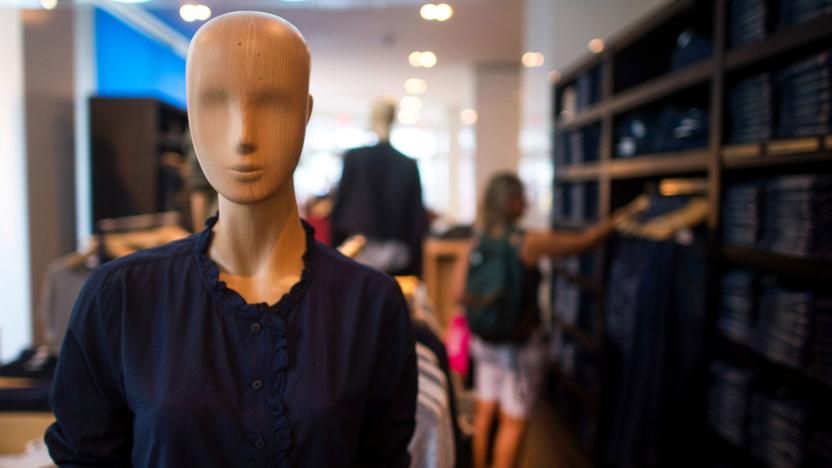phab2pro
Latest

Gap envisions a future with augmented-reality 'dressing rooms'
Fashion brands know experimenting with tech is imperative, whether it be to enhance the retail experience or introduce fans to the concept of virtual reality. For Gap Inc., which, in addition to its eponymous label owns Banana Republic, Old Navy, Athleta and Intermix, technology has never played a major role in its business strategy. But as the company struggles with declining sales, it's trying to find creative ways to engage with customers. That's where Gap's "DressingRoom" app will come in when it launches in the coming days.

Pros and cons: Our quick verdict on Lenovo's Phab 2 Pro
Lenovo's Phab 2 Pro has a mouthful of a name and a somewhat bland design. But what might seem like a forgettable phone really isn't: This massive 6.4-inch handset is the first available phone with Google's "Tango" 3D mapping technology. But while Tango feels magical when it works, bugs and hiccups periodically dampen the experience. Indeed, as is the case with many first-generation technologies, you're better off waiting for refinements -- that is, unless you're the sort of early adopter who needs to be on the bleeding edge. (And if you are, the $499 asking price is reasonable considering how much flagship phones typically cost.) The problem is, once you set aside Tango (which itself isn't perfect), you're left with one lackluster phone. Though well-constructed, the design isn't memorable, while the cameras and custom software are downright lousy. The possibly too-big screen will also be a deal-breaker for some. Basically, then, as cool as Tango is, you're better off waiting for the technology to improve, and for a wider variety of devices to support it.

Lenovo Phab 2 Pro review: Stumbling out of the gate
I just spent 15 minutes wandering around the office, trying to shoot ghouls in the face with lightning. Before that, I dropped a virtual rococo sofa into the empty space next to my desk, just to see if it would fit. And before that, I measured ... well, everything. Welcome to the augmented life, courtesy of Google and Lenovo. Google has spent more than two years taking its "Tango" technology from project to full-blown product. The goal: to help our gadgets examine the world around them and overlay information -- or even whole new worlds -- on top of the reality we already know. Along the way, Google tapped Lenovo to help craft the first consumer-ready Tango device: an enormous slab of a phone called the Phab 2 Pro. And now it's here. If the Tango stuff alone didn't make the Phab 2 Pro a groundbreaking device, this is also the first Lenovo-branded smartphone to land in the United States. Too bad it's not quite ready for prime time.

The first Google Tango phone launches with over 35 new apps
It's been years in the making but Tango, Google's depth-sensing technology, is ready to make its consumer debut. That's because today is when the first Tango phone, the Lenovo Phab2 Pro, goes on sale for $499. To accompany the Phab2 Pro's launch, Google is announcing more than 35 new Tango apps, all of which will be available in the Play Store today. I had a chance to play around with several of them, as well as speak with a few app developers and delve further into the future of Tango. And that includes Tango's relationship with Daydream, another well-known Google project.

The first Project Tango phone goes on sale next month
Project Ara is no more, but that doesn't mean Google's weirder smartphone ambitions are all dead and buried. Project Tango -- a push to put 3D mapping in a smartphone -- is still alive and well, thanks to Lenovo. Speaking to CNET, Google's Clay Bavor confirmed that the Phab2 Pro should be coming out next month. The phone promises to track your surroundings and then, augmented reality style, display content that looks like it's right in front of you. With this, you could visualize new furniture in your home, or shoot aliens that appear to be coming out of the walls.

The After Math: Can't buy me love
There's something in the air this week. Seems everybody's in L-O-V-E, love. Well, except maybe this guy. Researchers successfully tested a new gene therapy using the DNA from three donors. Lenovo debuted the world's first Tango-enabled smartphone. Tinder kicked all the kids out and Google's gave its devs something to crow about. Numbers, because how else would we know that one is the loneliest?

Up close and personal with the first Tango phone
For years now, we've watched Google build gadgets that sense the world around us, and for years we've wondered when the non-coding public could actually use them. That time is, well, not now but soon. Lenovo unveiled the Phab2 Pro earlier today, a smartphone whose name completely fails to illustrate its potential importance: the very first phone using Google's Tango 3D mapping technology that a regular person can actually buy. It doesn't arrive until later this summer, but after spending a little time with the device, I'm already cautiously optimistic about its potential.

$500 Lenovo Phab2 Pro is the first Google Tango phone
The second generation of Lenovo's Phab phones are here already, headlined by the first-ever Project Tango-equipped smartphone with sensors and cameras that can map its surroundings. The Phab2 Pro (check out our hands-on impressions right here) is special because it fulfills the promise of demos that Google's Advanced Technologies and Products (ATAP) division has been showing us for a few years. The phone's dual cameras create an "eye" that sees its surroundings in 3D with depth perception, while additional sensors monitor location and nearby objects 250,000 times per second.






